The New Moon Eclipsed, Hanukkah Happens, Planets Gathered in Evening, and Night Sights in Cassiopeia and Andromeda!
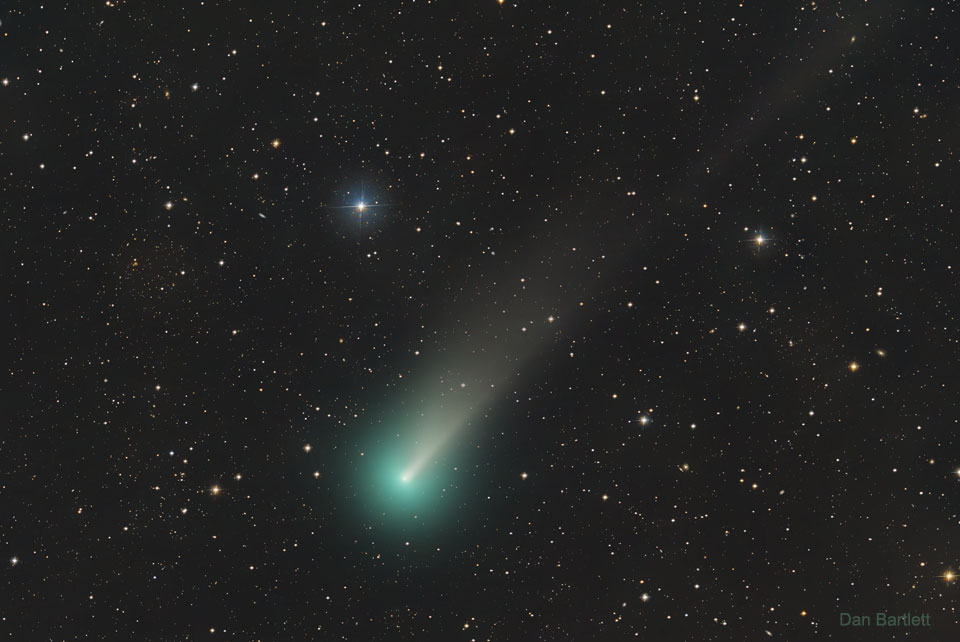
This image of Comet C/2021 A1 (Leonard) was taken recently by Dan Bartlett from a dark sky site above the Eastern Sierras Mountains in California. The coma’s greenish glow should be apparent in a telescope. The dust tail may be a challenge. The image was featured as NASA’s APOD for November 21, 2021
Hello, Stargazers!
Here are your Astronomy Skylights for the week of November 28th, 2021 by Chris Vaughan. Feel free to pass this along to your friends and send me your comments, questions, and suggested topics. You can also follow me on Twitter as @astrogeoguy! Unless otherwise noted, all times are expressed in Eastern Time. To subscribe to these emails please click this MailChimp link.
I can bring my Digital Starlab portable inflatable planetarium to your school or other daytime or evening event, or teach a session online. Contact me through AstroGeo.ca, and we’ll tour the Universe, or the Earth’s interior, together! My terrific new book with John A. Read entitled 110 Things to See With a Telescope is a guide to viewing the deep sky objects in the Messier List – for both beginners and seasoned astronomers. DM me to order a copy!
The moon will spend the week waning towards new moon, culminating with a total solar eclipse visible from Antarctica on Saturday. Comet Leonard will be brightening in the eastern post-midnight sky, and Mars will climb into view before sunrise. The moonless evenings worldwide will be ideal for appreciating the sights in Cassiopeia and Andromeda. And the western sky after sunset will host a gathering of the bright planets Jupiter and Saturn – and Venus, which will peak in brightness this week. Read on for your Skylights!
Hanukkah and the Jewish Calendar
Astronomy is a secular science – but there is plenty of astronomy embedded within religious and cultural traditions around the world. Let’s look at Hanukkah (or Chanukah, meaning “dedication/consecration/housewarming”, which begins today, Sunday, November 28 at sundown.
Since ancient times, most cultures around the world have designed their calendars around the visible cycles of the moon, and the sun’s apparent passage through the stars. The Jewish lunisolar calendar uses the first appearance of the young, crescent moon to begin a month. But the moon’s phases repeat every 29.5 days, so that missing half-day needs to be factored in by making some months only 29 days in length – the chaser “missing” months – and other months 30 days in length – the malei, “full” months.
To account for the ten-day difference between the length of the solar year and twelve 29.5-day lunar months, and to ensure that the calendar of Jewish observances remains synchronized with the seasons, a leap-month is added every two or three years on a repeating 19-year Metonic cycle. On those years, the springtime month of Adar is observed twice consecutively.
Nissan, the first month in the Jewish calendar, begins with the new moon following the March Equinox. But the Jewish New Year, which is said to honour the anniversary of the creation of Adam and Eve, occurs on the first day of the seventh month, which is named Tishrei. That month always falls in September-October on our western Gregorian calendar.
The month of Tishrei hosts the Jewish High Holidays – Rosh Hashanah and Yom Kippur, plus the significant days of Sukkot, Shimini Atzeret, and Simchas Torah. Rosh Hashanah, which marks Jewish New Year, falls on Tishrei 1. Yom Kippur “day of atonement” falls on the tenth day of the seventh month.
Hanukkah, or the Festival of Lights, is observed for eight nights and days, starting at sunset on the 25th day of the Hebrew month Kislev, which may occur at any time from late November to late December in the Gregorian calendar. The last new moon was on November 4, so Hanukkah commences tonight and ends on sundown on Monday, December 6.
Hanukkah commemorates the victory of the Maccabees over the Syrian Greek army in the 2nd Century BCE, allowing the Maccabean Jews to rededicate their Holy Temple in Jerusalem and to restore its menorah, or lamp. The Miracle of Hanukkah is that only one vial of oil was found, just enough to illuminate the Temple lamp for one day, and yet it lasted for eight full days. Eight candles on a nine-branched hanukkiah are lit by using the central “attendant” candle to light one more candle each night – until all nine candles shine on the final night. Traditional Hanukkah foods are deep fried in oil in memory of the temple lamp.
This year’s High Holidays and Hanukkah arrived unusually early. But the leap-month of Adar II added in spring, 2022 will re-align them for next year.
The Jewish, Christian, and Muslim calendars all share similar roots, which is why Passover and Easter, and Christmas and Hanukkah, are often coincident. The Muslim calendar is allowed to drift due to the ten-day lunar-solar difference, but it resets every 33 years. The Muslim New Year occurs at the Vernal Equinox – but that’s a story for another time.
Telescope Buying Tips
If you missed last week’s notes about buying a first telescope, I posted it here.
Jenna Hinds, Allendria Brunjes, and I covered holiday gift ideas for stargazers and astro-gadgets on Insider’s Guide to the Galaxy this week. It’s on YouTube at
https://www.youtube.com/watch?v=2VsrjxJzejs.
Comet Leonard Update
A comet named C/2021 A1 (Leonard) is predicted to brighten enough to see with unaided eyes in mid-December, when it will appear in the eastern sky before sunrise. The comet was discovered by G. J. Leonard at the Mount Lemmon Observatory on January 3, 2021, when the comet was 5 AU (or 750 million km) from the Sun.
For now, the comet is shining around magnitude 8, well within reach of backyard telescopes from a dark location, and possibly larger binoculars. This week the comet will rise at about 12:30 am local time and then climb the eastern sky until dawn. For the next week, Comet Leonard will be located above (or celestial northwest of) the very bright star Arcturus. Comets move rather quickly compared to the background stars. This week it will traverse 1.4 fist diameters or 14° of sky, more or less toward Arcturus!
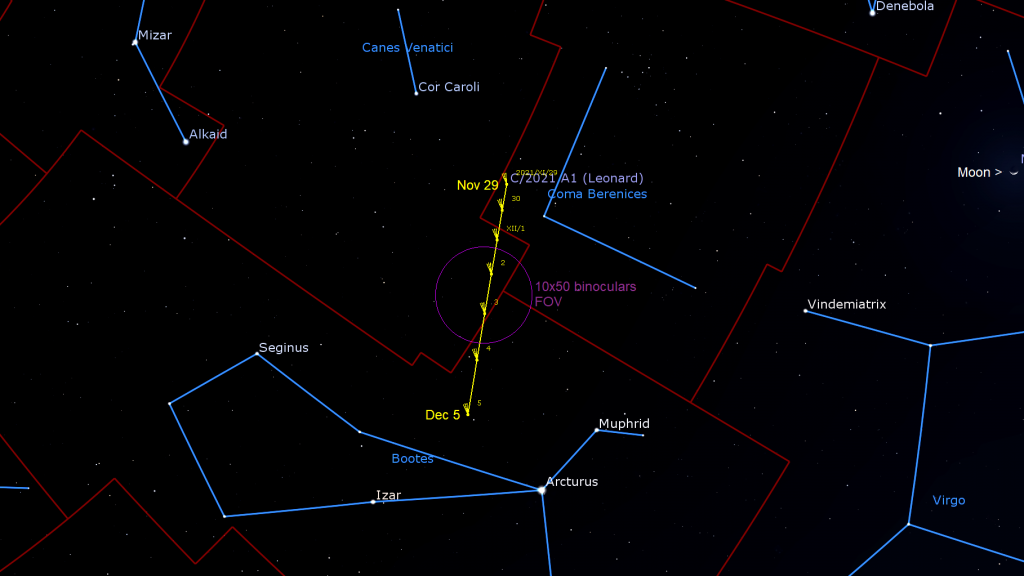
In the pre-dawn sky from Monday to Friday, the comet will be moving along the border between Canes Venatici (the Hunting Dogs) and Coma Berenices (Berenice’s Hair). On the coming weekend it will enter Boötes (the Herdsman). The waning crescent moon will share the morning sky with it until about Friday.
If your location is dark, try seeing the comet in binoculars, especially later in the week. It should resemble a faint fuzzy patch or unfocused star. Look for its fainter tail extending roughly upwards, i.e., pointed away from the horizon. In a telescope, you may see a faint hint of green. Always begin with your lowest power eyepiece. If you use Stellarium or an app, you should update the orbital elements for solar system objects so that the comet’s position is plotted correctly. Then use the app’s flip buttons to show the same orientation that your telescope produces, and find the star patterns that should be surrounding the comet. Finally, if you aren’t seeing it yet, try tapping the telescope while you are looking. Making a faint fuzzy object “dance” a little will make it more visible.
On Friday morning, December 3, Comet Leonard will pass very close to the bright globular star cluster named Messier 3 in Canes Venatici. Both objects should be bright enough to see in binoculars from dark sky locations, and will be telescope-close for several hours. On the following night, the comet will pass another, fainter globular cluster named the Snowglobe or NGC 5466.
The comet should brighten every morning as it nears the warmth of the sun. But it will also be shifting closer to the sun in the sky – by descending toward the horizon. By the time we get to the predicted peak brightness next week, it will be rising closer to sunrise. That means it will sit lower and shine through a thicker layer of Earth’s distorting atmosphere, in a brightening sky. So look sooner than later! And, once you’ve successfully found and seen it, it will be easy to do that again each consecutive morning.
Comet Leonard will pass the sun and enter the evening sky after mid-December – but it won’t climb far above the western horizon. And there’s no guarantee that it will survive as it nears perihelion on January 3, 2022. So check the weather forecast and set the alarm!
The Moon
The moon will spend this week travelling sunward in the post-midnight sky, leaving evenings worldwide dark and moonless for star lovers! The moon won’t be completely out of sight, however. Before dawn, you can see its slim crescent shining among the stars of Virgo (the Maiden) from Monday to Wednesday morning – and then shining faintly in the early morning daytime, too.
In the southeastern sky before dawn on Thursday, the silver sliver of the old moon will shine a palm’s width to the upper right (or 7 degrees to the celestial northwest) of magnitude 1.6 Mars. Use binoculars to look for the bright double star Zubenelgenubi (or Alpha1,2 Librae) positioned just to the moon’s lower right. Try to see them shortly before 7 am local time. Half a day later, observers in most of Mongolia, northeastern China, parts of eastern Russia, Japan, most of Micronesia, northern Polynesia, and Hawaii can see the moon occult Mars. On Friday morning, the moon will drop to Mars’ lower left.
On Saturday, December 4 at 2:43 am EST or 07:43 Greenwich Mean Time, the December new moon will occur. At its new phase, the moon is travelling between Earth and the sun. Since sunlight can only reach the far side of the moon, and the moon is in the same region of the sky as the sun, the moon becomes completely hidden from view for about a day. New moon will occur only two hours before the moon reaches perigee, its minimum distance from Earth, producing high tides around the world.
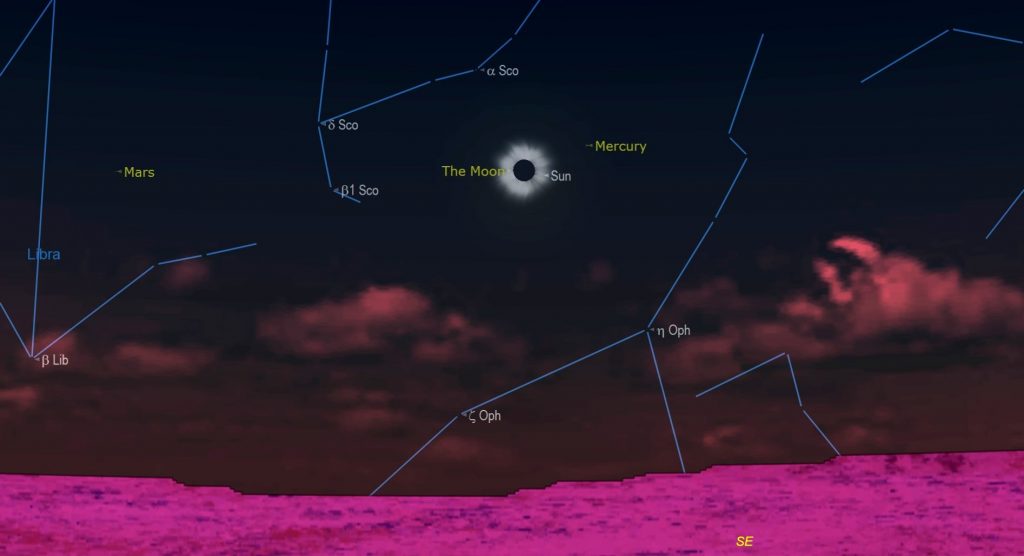
This new moon will also produce a total solar eclipse visible inside a narrow track that crosses West Antarctica and the Ross Sea. The partial eclipse will be visible over the rest of Antarctica, South Africa, Tasmania, and the South Atlantic. Some sites may live be streaming the event. Totality will occur at about 07:33 GMT or 2:33 am EST (it depends where their cameras are located), and the moon will be taking its “bite” out the sun for about an hour on either side of that time.
The moon will end this week as a young crescent shining low in the southwestern sky after sunset on Sunday.
Dark Sky Treats
The moonless evenings this week will be ideal for stargazing. To get you started, I posted detailed tours of the constellation Cassiopeia (the Queen) last December here and her daughter Andromeda (the Princess) in November, 2020 here.
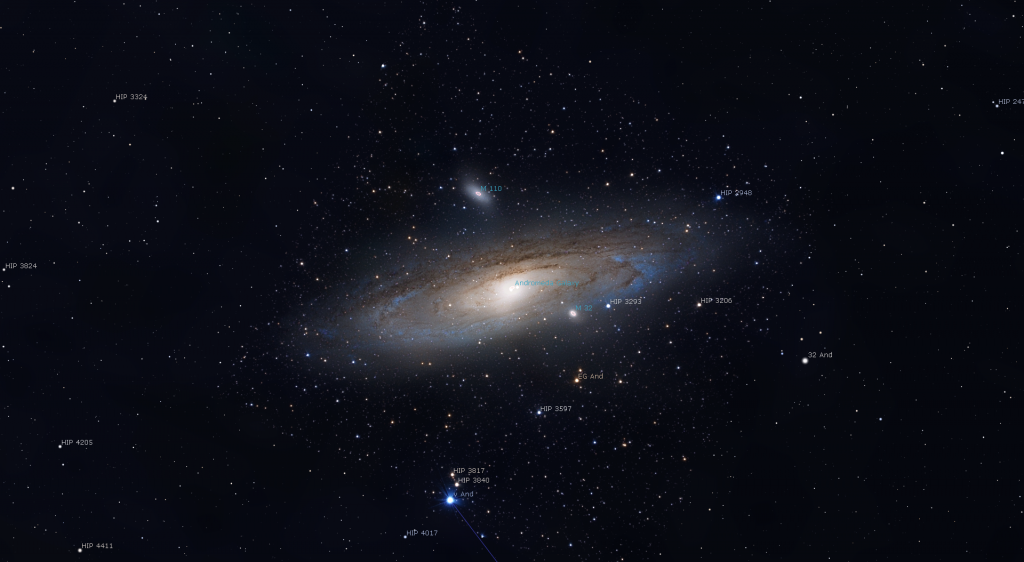
The Planets
Three bright planets will share the southwestern sky after sunset during most of December – especially around December 18. For now, extremely bright Venus is positioned about 3.5 fist diameters to the lower right (or 35° to the celestial west) of bright Jupiter – with fainter Saturn between them. Venus’ eastward orbital motion with respect to the background stars will continue until December 18. Meanwhile, the two gas giant planets are being carried west and sunward by Earth’s orbital motion. So the trio of planets will decrease their separation nightly until then.
This week, brilliant Venus will shine low in the south-southwestern sky after sunset, and then set at about 7:30 pm local time. You might need to walk around to find a view of the planet between the trees or buildings after sunset. On Friday, Venus will achieve maximum brightness for its current lengthy evening apparition. Astronomers call this event “greatest illuminated extent”. The term refers to the optimum combination of the planet’s apparent disk size (41 arc-seconds) and its illuminated phase (26%) sending a maximum amount of reflected sunlight towards Earth. That evening, Venus will shine at a spectacular magnitude –4.66.
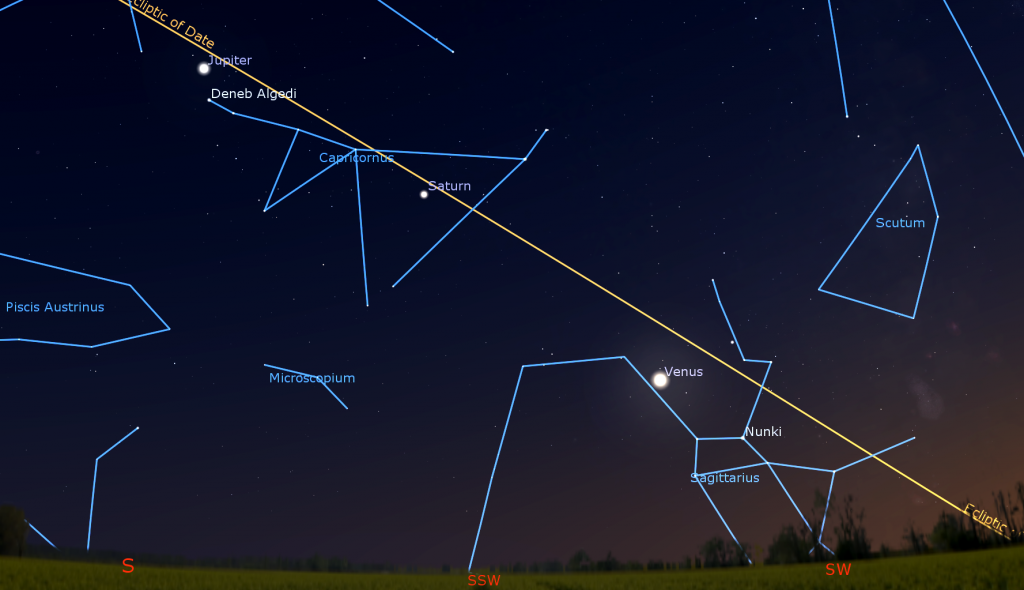
Viewed in a telescope, Venus will appear less than half-illuminated, on its sun-facing side. Aim your telescope at Venus as soon as you can spot the planet in the sky (but ensure that the sun has completely disappeared first). That way, the planet will be higher and shining through less distorting atmosphere – giving you a clearer view of it. A brighter sky will also allow Venus’ shape to be seen more readily. The planet will grow in size and wane in phase every week for the rest of this year because Venus will be traveling into the space between Earth and the sun.
Jupiter and Saturn, parked at the opposite ends of the constellation of Capricornus (the Sea-Goat), will become visible a short time after dusk. Look for them shining less than a third of the way up the south-southwestern sky. You’ll need the sky to darken a little more before 18 times fainter Saturn appears. It’s 1.5 fist diameters to Jupiter’s right (or 15.5° to the celestial west). Jupiter and Saturn will set in the west, 90 minutes apart, after mid-evening – so observe each planet as early as you can spot it, while it’s higher. And, don’t dawdle – they’ll become unobservable in telescopes within a few weeks!
Saturn and its beautiful rings are visible in any size of telescope. If your optics are sharp and the air is steady, try to see the Cassini Division, a narrow gap between the outer and inner rings, and a faint belt of dark clouds encircling the planet. Remember to take long, lingering looks through the eyepiece – so that you can catch moments of perfect atmospheric clarity.

From here on Earth, Saturn’s axial tilt of 26.7° lets us see the top of its ring plane, and allows its brighter moons to array themselves all around the planet. Saturn’s largest and brightest moon Titan never wanders more than five times the width of Saturn’s rings from the planet. The much fainter moon named Iapetus can stray up to twelve times the ring width during its 80-day orbit of Saturn. The next brightest moons Rhea, Dione, Tethys, Enceladus, and Mimas all stay within one ring-width of Saturn.
During this week, Titan will migrate counter-clockwise around Saturn, moving from the lower left (celestial southeast) of Saturn tonight to the right (celestial west) of Saturn next Sunday. (Remember that your telescope will probably flip the view around.) How many of the moons can you see in your telescope?
Binoculars and small telescopes will show you the Jupiter’s four large Galilean moons named Io, Europa, Ganymede, and Callisto. Since Jupiter’s axial tilt is a miniscule 3°, those moons always look like beads strung on a line that passes through the planet, and parallel to Jupiter’s dark equatorial belts. That line of moons, and the belts, tilt as Jupiter crosses the sky. The moons’ arrangement varies from night to night. Io, for example, orbits Jupiter once every 42 hours. From one night to the next night, 24 hours has elapsed on Earth – time for Io to complete half an orbit and shift from one side of Jupiter to the other. The other Galilean moons move less rapidly, taking between 3.5 and 16.7 days to orbit Jupiter.
For observers in the Eastern Time Zone with good telescopes, the Great Red Spot (or GRS) will be visible while it crosses Jupiter after dusk on Wednesday and Friday, and in mid-evening on Tuesday and next Sunday.
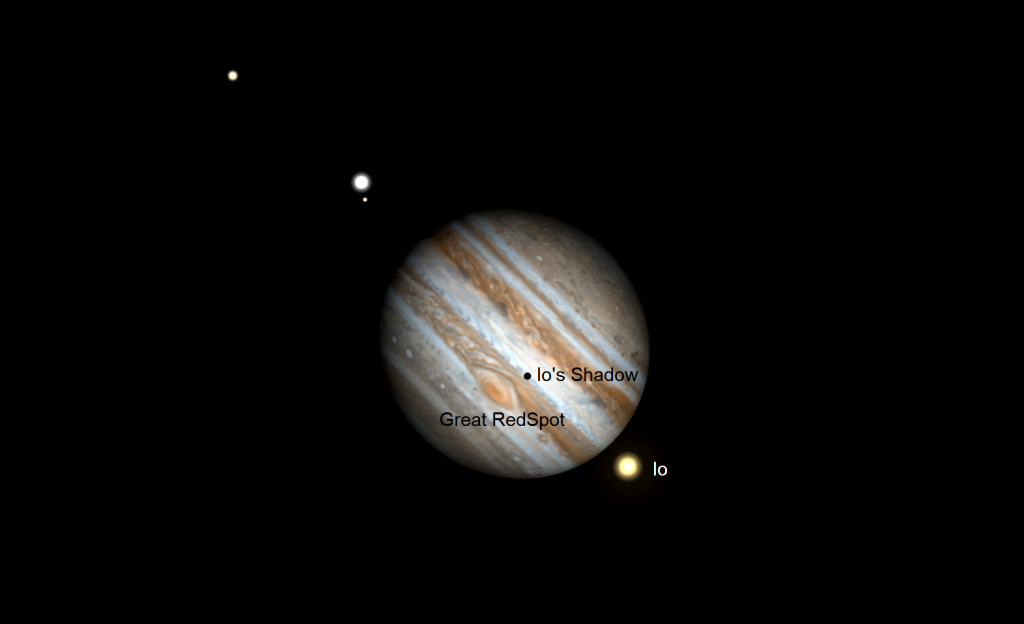
From time to time, the small, round, black shadows cast by Jupiter’s Galilean moons become visible in amateur telescopes when they cross (or transit) the planet’s disk. On Sunday evening, November 28, observers in the Americas can watch the small, black shadow of Jupiter’s moon Io move across Jupiter’s disk, accompanied by the Great Red Spot! The pair will begin to cross at 6:20 pm EST, or 23:20 GMT. The transit will last for approximately 2 hours. For observers in the western USA and Canada, only the later stages of the event will be occurring in a dark sky.
Distant, dim Neptune is in the evening sky – near the border between Aquarius (the Water-Bearer) and western Pisces (the Fishes). The magnitude 7.86 planet is also 2.5 fist diameters to the upper left (or 26° to the celestial east) of Jupiter. On Wednesday, Neptune will complete a retrograde loop that has been carrying it slowly westward through the stars of northeastern Aquarius since late June. After pausing tonight, Neptune will return to its regular eastward motion.
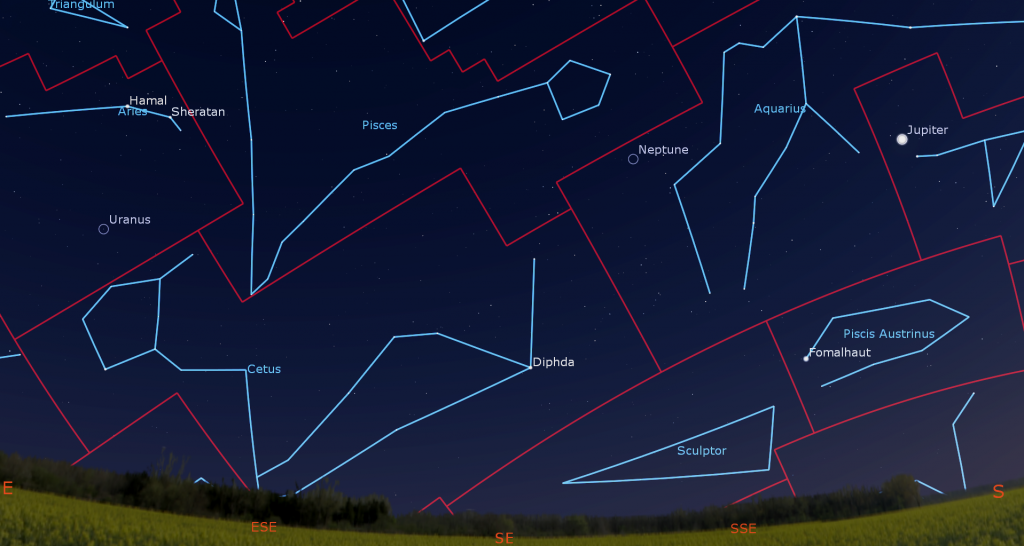
If the sky is very dark, Neptune can be seen in good binoculars. To locate it, find the up-down grouping of five medium-bright stars Psi, Chi, and Phi Aquarii (or ψ, X, and φ Aqr). Neptune’s non-twinkling speck will sit several finger widths to the left (or 3 degrees to the celestial NNE) of the top star, Phi. Viewed in a telescope, Neptune’s apparent disk size will be 2.3 arc-seconds. Your best views will come in mid-evening, when the blue planet is highest in the southern sky.
Uranus is shining at magnitude 5.66. Look for the planet’s small, blue-green dot moving slowly retrograde westwards in southern Aries (the Ram), a fist’s width below (or 11.5 degrees southeast of) that constellation’s brightest stars, Hamal and Sheratan. Or use binoculars to locate Uranus using the nearby star Mu Ceti. Uranus is also about 1.6 fist diameters to the upper right (or 16 degrees to the celestial west-southwest) of the Pleiades star cluster. This week Uranus will be observable all night long – especially around 10:30 pm local time, when it will have climbed more than halfway up the southeastern sky.
This week Mars will continue to increase its angle from the sun – just beginning its year-long journey to a bright showing at opposition in December, 2022. You might spot the magnitude 1.6 planet shining very low in the east-southeastern sky just after it rises at around 6 am local time, especially if you live at a tropical latitude. Your odds of successfully spotting Mars will improve on each subsequent morning. Take care to turn binoculars and telescopes away from the eastern horizon well before the sun rises. The old crescent moon will shine near Mars on Tuesday and Wednesday morning.
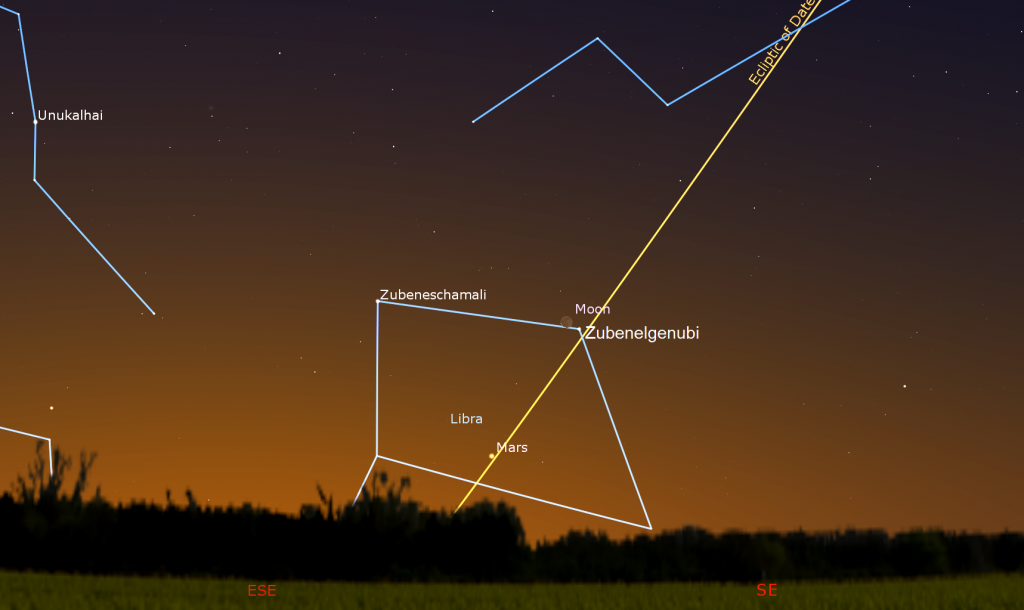
The Brightest Stars of November
Last week here I wrote about the brightest stars in the evening sky.
Public Astro-Themed Events
Every Monday evening, York University’s Allan I. Carswell Observatory runs an online star party – broadcasting views from four telescopes/cameras, answering viewer questions, and taking requests! Details are here. Their in-person Wednesday night viewing has been converted to online via the observatory YouTube channel.
On Wednesday evening, December 1 at 7:30 pm EDT, the RASC Toronto Centre will live stream their monthly Recreational Astronomy Night Meeting at https://www.youtube.com/rasctoronto/live. Talks include The Sky This Month, processing astro-images, and chasing the Aurora Borealis. Details are here.
On Thursday night, December 2 at 7 pm EDT, SkyNews Magazine and the Royal Astronomical Society of Canada will present the online program Mi’kmaw Moons. Cathy LeBlanc, Holly, and Dave Chapman will share how, for more than seven years, the Mi’kmaw Moons project has tied visual astronomy and Mi’kmaw storytelling together using the Two-Eyed Seeing approach, embracing both Indigenous and Western traditions in how we view the world. Details are here, and the registration link is here.
My free, family-friendly Insider’s Guide to the Galaxy webcasts with Jenna Hinds of RASC National returns on Tuesday, December 7 at 3:30 pm EST, when we’ll cover the biggest events in astronomy during 2022. You can find more details and the schedule of future sessions here.
Don’t forget to take advantage of the astronomy-themed YouTube videos posted by RASC Toronto Centre and RASC Canada.
Keep looking up, and enjoy the sky when you do. I love questions and requests. Send me some!